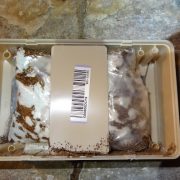Termite Mud Tubes
The thin brown line running down the side of the foundation in the photo is a termite mud tube. New England is home to Eastern Subterranean termites. Termites depend on a moist environment to survive. Moisture is the primary factor to sustain a termite colony. The relative humidity in a termite tunnel is nearly 100%. Termites must build a shelter tubes to move across exposed surfaces like this solid concrete foundation. Termite mud tubes keep light out and moist, warm air inside. Termites feed on cellulose. Wood is a preferred food source. Our homes contain a lot of wood and wood products like paper. Mud tubes that protect the termites from drying out are important because the wood in a home is elevated off the ground on a foundation. It stands to reason that to access a home termites will need to leave the soil and get up above the foundation. The mud tube structure lets termites reach food sources like your home.
How big is a termite? What does a termite look like?
Termites are the size of a small ants. The termite has no pigment. They are the size of a grain of rice with a creamy white color.
How to Identify a Termite Infestation
One of the biggest signs of an infestation is mud tubes. But why do termites build these tubes? Termites are wood-destroying insects that need to live in nearly 100% humidity. Their bodies quickly dry out if they are exposed to the elements. In order to protect themselves, they build mud tubes that provide them with protection from drying out — and also provide you with a sign of their presence.
What Termite Mud Tubes Look Like
Termite mud tubes are light brown like dried mud. A common example is in the photo on this page, but there are a few types of termite mud tubes. Their working tubes go from the soil to a food source. The exploratory tubes go through the soil. A termite drop tube is a pathway from the wood back to the soil. The width varies depending on usage – a heavily traveled tube can be several inches wide.
Signs of a Termite Infestation
Termite mud tubes can be difficult to see if they are located from the soil of a crawl space to the wood of a house. In slab, split-level or split ranch style homes mud tubes may be in bath traps, utility rooms, and under stairways. Since their color often blends in with the foundation of your home, you will need to walk around the perimeter of your house and look closely for tube-like structures. If you see one of these tubes, break a section the width of your finger. Check again in a few days. Active termites will repair the tube.
If you think you have a termite infestation at your home or business, contact us to arrange for a termite inspection right away! Experienced pest control professionals can verify if what you see is a termite tube, and they can also check for other signs of termite activity.
How do termites build mud tubes or shelter tubes? What are termite drop tubes?
They build mud shelter tubes by cementing grains of soil with saliva. Mud tubes that are not attached to a structural element like a wall are known as drop tubes. These come out of wood elements and head back to the ground. Drop tubes are used to find quick access to moisture containing soil.
Why do termites have mud inside the damaged or eaten wood?
Termites bring soil inside wood. It is to plastered against the walls to control humidity. Soil in the galleries is used to manage moisture in their environment. Termites have a thin exoskeleton and will dry out quickly unless high humidity is maintained. A broken termite mud tube causes a rush of air to leave. The air movement out of the colony as wet air moves to drier air alerts workers and soldier termites. Termite soldiers rush to the opening to defend it from attacking insects. Then termite workers plug the opening with dirt and fecal matter. Finally, when the hole is plugged the air movement out of the colony stops and the colony goes back to eating wood.
Exposed termite shelter tubes like one in the photo on the left easily are overlooked against gray foundations. To find them, first use a mirror to examine foundations close to the ground. They are difficult to see when grade (ground) height is close to or in contact with a structures siding. Next pay close attention to stone or cracked foundations. Those foundations disguise termite mud tubes from view. Finally, always use a flashlight when inspecting for termites.
How do I control termites?
Controlling termites in your property requires identifying areas termites are active. Active swarmers, swarmer wings and mud tubes are important ways to find termites. Termites eat from the inside out and do not travel exposed on surfaces. This aversion to exposure is essential to termite survival. Termites travel below the surface of the soil and eat wood from the inside out. Effective termite control starts with a thorough inspection. The most important termite inspection tool is a flashlight. The flashlight is necessary to find mud tubes. Next termite control material needs to be selected. The options are liquid or bait. Liquid termite control must be applied to the soil under the home and adjacent to the foundation. Termite baits are applied to the soil adjacent to the foundation. Above ground termite bait stations are applied directly over active termite mud tubes. Finally, a thorough treatment around the entire exterior perimeter that is accessible is important for termite control. Termites cannot be controlled with spot treatments.




